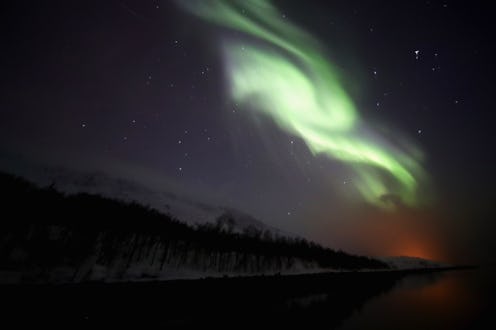Life
This Celestial Phenomenon's Name Is "Steve"

Strange events in the sky usually come with an even stranger name, but a mysterious celestial phenomenon called "Steve" has recently been discovered, and its name is even odder than usual. The internet, of course, can't get enough of it — and for good reason. I mean, when was the last time some exciting, celestial activity was attached to a name so... well... regular?
Planets in our solar system typically have names derived from Roman or Greek mythology; indeed, the official names of planets and their moons are governed by a specific organization. Called the International Astronomical Union (IAU), this organization has, according to NASA, a "mission 'to promote and safeguard the science of astronomy in all its aspects through international cooperation.'"
But when it comes to other activities of the sky, it seems the naming process can sometimes be a community effort. Take what's going on in the sky in Alberta, Canada, for example. Amateur star-gazers looking for the northern lights discovered a curious streak of purplish light — and since no one is really quite sure what it is, everyone has taken to calling it simply, "Steve." Yes, even scientists.
According to CBC News, Eric Donovan, a professor of physics and astronomy at the University of Calgary described the lights as "a traditional auroral arc" during an appearance on the radio show Calgary Eyeopener. What's more, Donovan noted that they had been spotted by sky-watchers and researchers before: "We have seen it from Hudson Bay all the way over to Alaska in our data, and so it's like someone reached in from space and drew a line with a purple magic marker across the Earth," he said.
According to Space.com, Donovan first heard about "Steve" while communicating with amateur star-gazers in the Facebook group, Alberta Aurora Chasers. He later overheard others discussing in a pub that Steve may be a proton aurora. However, he knew this to be incorrect. Auroras happen when charged particles pushed away from the Sun are attracted to our planet's North and South poles by the magnetic field — they create bright streaks of color in the sky after hitting neutral particles in the upper atmosphere. Donovan knew a proton aurora could not be seen by the naked eye and became determined to find out exactly what the lights in the sky were. "Myself and some other scientists decided we were going to try and figure out what this thing was," CBC News reports him as saying.
Apparently members of the Alberta Aurora Chasers Facebook group had been taking photos of the mysterious lights over Canada for several years. Chris Ratzlaff, a photographer and the administrator for the group named the light Steve, after a scene in an animated movie called Over the Hedge, in which several of the animals characters called noises that they couldn't identify over the hedge, the same name.
Commenting on his choice, Ratzlaff according to CBC News, "t's a completely meaningless name, which is really useful for things that aren't understood." Once Ratzlaff spoke with Donovan to confirm the lights were indeed, not a proton, he wrote a post to the Facebook group urging others to call it Steve until more was known about it. In December, after concluding that Steve is actually a very hot ribbon of quickly-moving gas, Donovan presented his findings at a meeting in California and found by coincidence that the name "Steve" was both scientifically accurate and highly humorous. One audience member at the talk pointed out that because Steve is "'a sudden thermal emission through a velocity enhancement," the name just so happens to also be an acronym. (Get it? Sudden Thermal Emission through Velocity Enhancement? S.T.E.V.E.? Yup. That happened.)
The impact of citizen scientists on the scientific community is definitely exciting. As Space.com reports, Donovan noted during a recent talk at a science meeting called Swarm in Canada that scientists likely would have never pinpointed the newfound phenomenon without social media. Just 15 years ago, the costs for tracking down something as exciting as Steve could have totaled to $200 or $300 million, but today citizen scientists can do the job on social media and often get to work side by side with researchers as a result.
So is Steve here to stay? Donovan seems to think so, reports CBC News. Donovan commented during the California talk that the name is "nice" and... "injects a little bit of fun into our lives as scientists — not that we don't have fun, but this is more fun than normal."